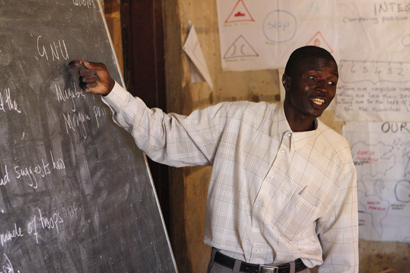Blog
-
“I’ve started something at Simakakata” - Headmaster George

George teaches the Grade 7 class about Zambia's role in the UN
At the weekend, George Matantilo likes to relax by working on his small farm, near where he lives in Good Hope. With the help of his sons, he grows a little maize and sweet potatoes, and looks after a herd of goats. On Sunday, like the majority of people in this strongly Christian country, he goes to church. In the afternoons he unwinds by watching sport on television.
He’s earned the downtime. His boss at the Education Board is worried about his gruelling schedule. Every weekday morning, hot or cold, wet or dry, he cycles 8km to Simakakata, where’s he’s headmaster of the community school. He arrives at 7am, and works for at least least nine hours before starting the journey home. Although the children have all left by 4pm and there’s no food or water at the school, George often works late. On top of his school duties, he runs a health outreach program from his unlit office.
“We look after those who are orphaned or children that are vulnerable, I also organise help for local people with HIV/AIDS. There are a group of care givers who go around the community collecting information, so that we know how people are getting along, what their problems are, and offer advice or arrange appointments at the clinic in Kalomo. One of the other thing that I do is that I’m the pay point manager for the old and disabled here – I go to the social welfare offices to collect their allowances for them.”
It’s hard work, but George shrugs off the tiredness with a laugh.
“I’m an old man for a headmaster,” he jokes, “I’m 36 aready!”
George’s smile is infectious, but there are two dark truths behind his humour: many schools here are staffed by young, untrained teachers. More disturbingly, the HIV/AIDS epidemic has lowered the average life expectancy to under 41. Statistically, George really is an old man.
George’s hope
He lives with his wife, Linda, in a large, well equipped teacher’s house near the school in Good Hope. Until last year, George worked here: Linda still does. Unlike Simakakata, the school and surrounding area has access to power and water. The classrooms are well stocked, and there’s even an on-site science lab for Grade 8 students and above.
Fifteen years ago, though, Good Hope was identical to Simakakata. Then a German donor stepped in to kickstart the development of a new school building. As a direct result Good Hope and the surrounding area have been transformed beyond recognition, from a desperately poor rural community into a young, modern village which is growing every year.
George wasn’t offered more money to take up his new post, and there are few teachers with his experience that would accept a position at such an impoverished school. He’s here because he believes he can transform Simakakata in the same way. It’s draining, but behind his polite, unassuming nature George is tougher than a boxset of Bogarts.
“Somewhere in November last year,” he admits, “The Education Board offered me another job, closer to home, where the head teacher was retiring. They looked at how tired I was, travelling to school on my bike, working late, and organising so much. I said, ‘No, I’ve already started something at Simakakata, I must see it through to the finish. If I leave, who is going to see this through to being a proper school?’ So I remain here, and I keep on cycling, working with the children, working with the other teachers.”
If you would like to help fund a new classroom, teacher’s house and bore hole at Simakakata you can make a donation by clicking here. We’ll post updates on this blog so you get to see your money in action.
1 comment